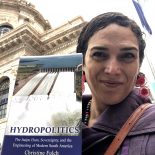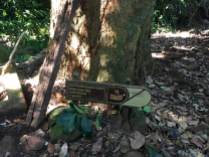Geoengineering to Save Paraguay’s Forests, Past & Future

When Swiss naturalist Moises Bertoni first visited the Paraguayan banks of the mighty Paraná river in 1884, he found a sparsely populated land. Much of Paraguay’s population had died fighting or in the aftermath of the War of the Triple Alliance (1864-1870) and many of the trees had been cleared for industrial use. Bertoni decided to make his home in the humid Atlantic Forest, where he constructed a scientific laboratory to run experiments–you can still see specimens preserved in formaldehyde. With a humble printing press, he published academic journals out of his scientific imprint Ex silvis (“out of the jungle”). And he reforested the area using native and non-native trees–a living bio-experiment of geoengineering.

What it actually looks like. You should visit Paraguay. It’s awesome.
It worked. Today, the site of his abode is a 199 hectare nature reserve, a bird-watcher’s haunt filled with soaring trees welcoming visitors from all over the world.
Which is why it’s utterly scandalous that everything but those famous 199 hectares has been cut down in recent years. Paraguay has one of the world’s fastest rates of deforestation–6th fastest, according to some reports. Photos from space of its newly cleared forest made NASA’s “Image of the Day” this year. And the approach to the Moises Bertoni Monument is now an ocean of soy. The iron-rich soil looks like a bleeding gash in the earth.

Soy plantation on newly cleared land, en route to Moises Bertoni, Alto Paraná.
Paraguay is the world’s 4th largest soy exporter (behind Argentina, Brazil, and the U.S.) and much of the land that’s being cleared is planted with soy. Soy takes the fertility of the land, sells it abroad, and returns very little to Paraguay (generating few jobs because of how automated it is). The tax on soy production in Paraguay is 10% (down from 15%), much lower than its neighbors. Argentina, for example, taxes soy exports ~40%.
It’s also the world’s top per capita exporter of hydroelectricity. Paraguay has a massive electricity surplus–all carbon-free, renewably generated from hydropower. To be technical about it, it uses 11,000 gigawatt hours a year and sells 40,000 gigawatt hours to its neighbors Argentina and Brazil. Most of that 40,000 gigawatt surplus is sold to Brazil for a below-market price and the little that goes to Argentina is sold for basically nothing (it goes to pay off the construction debt).
Why the excursus on energy? Because, as we learned this summer via field visits to the Paraguayan countryside: the soy industry runs on firewood. We saw mountains of firewood in neat stacks, waiting to be burned to process soybean oil–the same wood from the newly cleared forests.

Firewood for industrial use in Paraguay.
It’s shortsighted, carbon-emitting, and not sustainable. But the example of Moises Bertoni shows a way ahead, innovating on the successful 19th century geoengineering experiment to which the Swiss scientist dedicated the rest of his life. Deep in the department of Itapua, a yerba mate company has launched an experiment: to grow high-quality, organic yerba on hilltops with the mix of native fauna and flora that would be found in the wild. Yerba Mate Pajarito even brought in a botanist to walk the orchard and identify any non-native plants or trees, which were summarily removed.

Yerba mate growing amid native shade trees and flora, Itapua.
The organic yerba produced this way has a much more complex, well-balanced flavor and is produced in smaller, high-quality batches than the stuff that comes from mono-crop orchards. The price point is also higher, but worth it. Other yerba mate cooperatives we visited are intentionally working with smallholder farmers and Indigenous communities to source the herbs that get mixed in with yerba mate, providing sustainably. These models demonstrate how to generate a better quality of life for ordinary Paraguayans while treating the land like a complex relationship of living things and not just a resource to be plundered.





